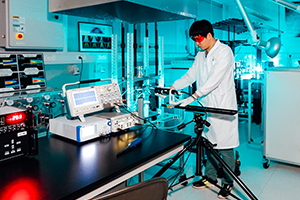


Brand: Litron
Model: Nano PIV

To characterize the propagation modes of flames, flame propagation speed of edge-flames must be accurately calculated. The PIV technique allows to identify significant modifications to the flow fields of unburned gases caused by thermal expansion of the propagating edges, which enables us to calculate true flame propagation speeds that take into account the flow velocities of unburned gases.
Flow field can also be visualized using Argon – Ion laser source of light to illuminate the experiment, and with of an ICCD camera to capture the images. The technique is applicable to a range of liquid and gaseous flows. The fluid is seeded with particles which are generally assumed to faithfully follow the flow dynamics. It is the motion of these seeding particles from which the velocity information is calculated. It is done by taking two images shortly after one another and calculating the distance individual particles traveled within this time. The displacement field is determined from the motion of the seeding particles between the two images. The velocity field is obtained by dividing the displacement field by the known time separation. A typical PIV setup consists of a CCD camera, high power laser, an optical arrangement to convert the laser output light to a light sheet, tracer particles and the synchronizer.